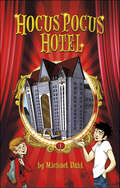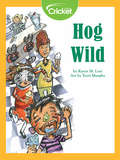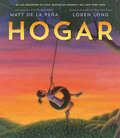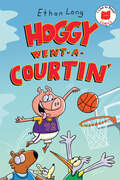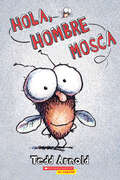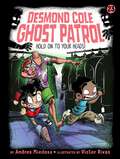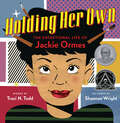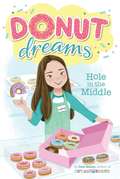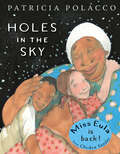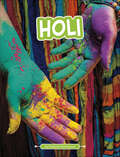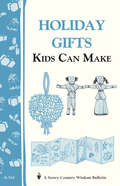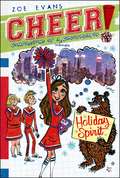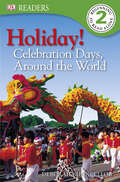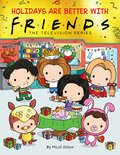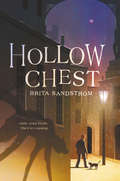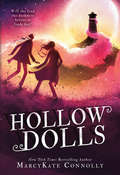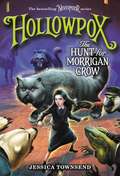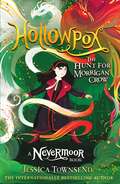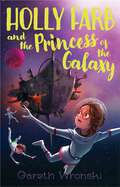- Table View
- List View
Hocus Pocus Hotel (Hocus Pocus Hotel)
by Michael DahlThe Abracadabra Hotel, built by and for magicians, has long been know to locals as the Hocus Pocus Hotel. Charlie Hitchcock has never stepped inside until Tyler Yu tells him to meet him there ...or else. As if the hotel's storied past isn't enough, it turns out that the place is inhabited by magicians, and while Charlie and Ty solve magical mysteries, the bully and the brain form an unlikely friendship.
Hofus the Stonecutter: A Japanese Folktale (Into Reading, Level Q #38)
by Joanne Barkan Richard DownsNIMAC-sourced textbook
Hogar (Home Spanish Edition)
by Matt de la PeñaHogar es una soñolienta canción de cunay un murmullo de tráfico que de nochese cuela entre tus cortinas. Hogar es la tenue sirena de una barcaza lejanamientras tu abuelo lanza el sedaldesde el borde de su casa flotante. Así comienza esta emocionante celebración del hogar en sus diferentes formas. Ya que el hogar es una idea más profunda que los muros que levantamos a nuestro alrededor. Es la familia que demuestra su amor por medio de pequeños gestos cada día. Es la comunidad que se apoya en los tiempos difíciles. Y es la maravilla del mundo natural, un refugio que compartimos con todo ser viviente en la Tierra. De Matt de la Peña y Loren Long, los creadores de Amor, el bestseller número uno del New York Times, llega esta sumamente emotiva oda a los lugares en donde nos sentimos seguros, amados y fieles a nosotros mismos, dondequiera que se encuentren.
Hoggy Went-A-Courtin' (I Like to Read Comics)
by Ethan LongGet in the game with Hoggy and friends in this comic for beginning readers!No one can catch Hoggy on the court. He&’s the best at dribbling, shooting, and scoring. But Hoggy is not the best when it comes to helping his teammates. To them, Hoggy showboats, over-dribbles, and doesn&’t pass the ball. When Hoggy&’s fed-up friends ask him to leave the game, Hoggy is faced with a big decision. Will he stay angry, or will he apologize and be a better teammate? Ethan Long's expressive, slapstick-style art shines in this story about teamwork, cooperation, and friendship—great for early comics and social emotion learning collections. Comics-lovers can now share the fun with their kids, students, siblings, and younger friends who are learning to read! I Like to Read® Comics are perfect for kids who are challenged by or unengaged in reading, kids who love art, and the growing number of young comics fans. Filled with eye-catching art, humor, and terrific stories these comics provide unique reading experiences for growing minds. I Like to Read® Comics, like their award-winning I Like to Read® counterpart, are created by celebrated artists and support reading comprehension to transform children into lifelong readers. We hope that all new readers will say, &“I like to read comics!&” A Junior Library Guild Gold Standard Selection
Hola, Hombre Mosca (Hombre Mosca)
by Tedd ArnoldFrom bestselling author/illustrator Tedd Arnold comes the hilarious FLY GUY!"Una mosca salió a volar. Quería comer algo, algo sabroso, algo pegajoso. Un niño salió a caminar. Quería cazar algo, algo muy especial, algo para llevar al Concurso de Mascotas".El niño y la mosca se encuentran y comienza una linda y divertida amistad."A fly was flying. He was looking for something to eat. Something tasty. Something slimy. A boy was walking. He was looking for something to catch. Something smart. Something for The Amazing Pet Show." The boy and fly meet and so begins a beautiful friendship. Using hyperbole, puns, slapstick, and silly drawings, bestselling author/illustrator Tedd Arnold creates an easy reader that is full of fun.
Hold On to Your Music: The Inspiring True Story of the Children of Willesden Lane
by Mona Golabek Lee CohenDiscover the inspiring illustrated true story about one girl's escape from the Holocaust to become a concert pianist against all odds, made popular by the beloved novel The Children of Willesden Lane.In pre-World War II Vienna, Lisa Jura was a musical prodigy who dreamed of becoming a concert pianist. But when enemy forces threatened the city—particularly the Jewish people that lived there—Lisa's parents were forced to make a difficult decision. They chose to send Lisa to London for safety through the Kindertransport—a rescue effort that relocated Jewish children. As Lisa yearned to be reunited with her family while living in a home for refugee children on Willesden Lane, her music became a beacon of hope for those around her.A true story of courage, survival, and determination, this compelling tribute to a gifted young girl has already touched the lives of many around the world. Originally published in 2017 for older readers, The Children of Willesden Lane has sold hundreds of thousands of copies globally; now this picture book retelling will inspire a new generation.
Hold on to Your Heads! (Desmond Cole Ghost Patrol #23)
by Andres MiedosoDesmond and Andres attract the attention of a spooky thrift store mannequin in this twenty-third haunted adventure in the Desmond Cole Ghost Patrol series!Thrift stores are a great place to look for ghosts. They love hiding in people&’s old stuff! But the Kersville Thrift Store has a totally different creature that&’s haunting its aisles…a mannequin that wants to thrift your head right off your shoulders! With easy-to-read language and illustrations on almost every page, the Desmond Cole Ghost Patrol chapter books are perfect for emerging readers.
Holding Her Own: The Exceptional Life of Jackie Ormes
by Traci N. ToddAn evocative picture book biography about the prolific life of Jackie Ormes, whose groundbreaking cartoons became some of the first empowering depictions of Black women in America! <p><P> Jackie Ormes made history. She was the first Black woman cartoonist to be nationally syndicated in the United States. She was also a journalist, fashionista, philanthropist, and activist, and she used her incredible talent and artistry to bring joy and hope to people everywhere. But in post-World War II America, Black people were still being denied their civil rights, and Jackie found herself in a dilemma: How could her art stay true to her signature "Jackie joy" while remaining honest about the inequalities Black people had been fighting? <P><P><i>Advisory: Bookshare has learned that this book offers only partial accessibility. We have kept it in the collection because it is useful for some of our members. Benetech is actively working on projects to improve accessibility issues such as these.</i>
Hole in the Middle: Katie And The Cupcake Cure; Sunday Sundaes; Hole In The Middle (Donut Dreams #1)
by Coco SimonHere's the latest fun, sweet series from the author of the Cupcake Diaries and Sprinkle Sundays series!Everything&’s better with a donut. Lindsay Cooper is about to start middle school. In her free time, she works at her family&’s restaurant, The Park View, handing out the world&’s most delicious donuts at the Donut Dreams counter. Her grandmother started the counter as a way to send Lindsay&’s dad to college, and Lindsay wants to use her job the same way—to make her dream of going to school far away from her small town a reality. Home feels different ever since Lindsay&’s mom passed away two years ago. And not having her mom around to help her get through the start of middle school doesn&’t help her &“first day of school&” angst. But with her cousins Kelsey and Molly by her side, not to mention her BFF Casey, Lindsay soon discovers family and friends go a long way towards filling any hole in your heart. And life can still be as fun as a pink donut with rainbow sprinkles!
Holes in the Sky
by Patricia PolaccoMiss Eula is back! In this heartwarming companion to Chicken Sunday, young Trisha is devastated when her grandmother passes away, but finds joy in bonds with a new friend, her new California neighborhood—and the invincible Miss Eula.There will never be anyone like her grandmother, Patricia Polacco thinks, when her grandmother passes away. But when she and her family move to California—in the middle of a drought—she meets a new friend, the irrepressible Stewart, and his amazing grandmother, Miss Eula, who not only takes Trisha under her wing, but, with Trisha and Stewart, steps up to lead their entire extraordinarily diverse neighborhood to help a hurting neighbor—and her once lush garden—survive the drought. Trisha's grandmother's old saying about the stars being Holes in the Sky turns out to be Miss Eula's, too, convincing Trisha that she has miraculously discovered another unforgettable grandmother.
Holi
by Ranjeeta RamkumarHoli is about celebrating the triumph over good and evil. It is also a celebration of love. It is a Hindu holiday. People have a bonfire to represent the story of Prahlad and Holika. They also gather in the streets to throw colored paint on one another and have a big feast. Readers will discover how a shared holiday can have multiple traditions and be celebrated in all sorts of ways.
Holi
by Ranjeeta RamkumarHoli is about celebrating the triumph over good and evil. It is also a celebration of love. It is a Hindu holiday. People have a bonfire to represent the story of Prahlad and Holika. They also gather in the streets to throw colored paint on one another and have a big feast. Readers will discover how a shared holiday can have multiple traditions and be celebrated in all sorts of ways.
Holiday Gifts Kids Can Make: Storey's Country Wisdom Bulletin A-165 (Storey Country Wisdom Bulletin Ser.)
by Editors of Storey PublishingSince 1973, Storey's Country Wisdom Bulletins have offered practical, hands-on instructions designed to help readers master dozens of country living skills quickly and easily. There are now more than 170 titles in this series, and their remarkable popularity reflects the common desire of country and city dwellers alike to cultivate personal independence in everyday life.
Holiday Spirit
by Zoe Evans Brigette BarragerJanuary 4 My teeny, weenie hotel room Holiday Spirit Level: Stuck Between a Rock and a Hard Place A spur-of-the-moment invite had me flying on New Year's Day with my dad and his girlfriend, Beth, to New York City! I was super excited to focus on fashion, not to mention have a real vacation. BUT that's not possible, since, you know, DRAMA follows me everywhere. Aside from scoping out a MAJOR Katie Parker lookalike here in the Big Apple, it seems the Grizzlies might not be able to compete in the novice Get Up and Cheer! competition Jacqui and I signed us up for because Katarina is failing Social Studies. AND this little vacay with Dad and Beth? NOT a vacay. They are moving here, and asked if I'd like to come with? SERIOUSLY!? Oh, and to top it all off, why oh why am I spending so much time thinking about Evan when I'm supposed to be in major LIKE with Bevan? So much for holiday spirit. Maddy can't wait to explore the fashion and glamour of the city, and a week away from everything back home is just what she needs. What could possibly go wrong on vacay, anyway?? That is, except everything. After this vacation, Maddy's going to need a VACATION! This third installment of CHEER! Confessions of a Wannabe Cheerleader is a hilarious yet poignant story about growing up, making choices, and spreading lots and lots of holiday spirit!
Holiday!: CELEBRATIONS AROUND THE WORLD (DK Readers Level 2)
by DKIt's time for fun and festivities - the year is full of days to celebrate! Learn about holidays all over the world with this Level 2 DK Reader. Packed with full-color photographs, lively illustrations, and engaging, age-appropriate stories to introduce young children to a life-long love of reading. These amazing stories are guaranteed to capture children's interest while developing their reading skills. Perfect for reading together! The playful images in this eBook are enhanced with entertaining animations and surprising sounds to bring this story to life.
Holiday!: CELEBRATIONS AROUND THE WORLD (DK Readers Level 2)
by DKIt's time for fun and festivities - the year is full of days to celebrate! Learn about holidays all over the world with this Level 2 DK Reader. Packed with full-color photographs, lively illustrations, and engaging, age-appropriate stories to introduce young children to a life-long love of reading. These amazing stories are guaranteed to capture children's interest while developing their reading skills. Perfect for reading together!
Holidays are Better with Friends (Friends Picture Book) (Media tie-in)
by Micol OstowHave a merry Christmas, happy Hanukkah, wonderful Thanksgiving, sweet Valentine's Day, and a whole lot more in this all-new official Friends picture book, based on the blockbuster TV show!"You can't have Thanksgiving without turkey. That's like Fourth of July without apple pie, or Friday with no two pizzas." - Joey TribbianiCelebrate all your favorite Friends holiday moments in this adorable picture book. From the Holiday Armadillo to Rachel's beef trifle to the Geller Cup, this book is packed with hilarious and relatable holiday moments featuring all your favorite characters. Rachel, Ross, Joey, Phoebe, Chandler, and Monica make every holiday fun . . . most of the time. After all, could this picture book be any more festive?
Hollow Chest
by Brita SandstromDebut author Brita Sandstrom arrives with an unforgettable modern folktale of the darkness around and inside us, and the courage it takes to keep hope alive. “Hollow Chest is remarkable on so many levels—its exquisite writing, its startling originality, its deep empathy. An astonishing debut.” —Anne Ursu, award-winning author of The Lost Girl Charlie has been having nightmares. Eyes watching him in the night, claws on his chest, holding him down. His dreams have been haunted for years, ever since German bombs rained down on London, taking his father’s life, taking his city’s spirit, taking his beloved brother, Theo, off to war in France.Now Charlie is left to take care of his grandpa Fitz while his mother works, waiting for the day when Theo will come home. And with World War II nearly won, that day is almost here. Grandpa Fitz warns Charlie that soldiers sometimes come back missing a piece of themselves, but Charlie isn’t worried. Whatever Theo has lost, Charlie will help him find it. When Theo finally does return, though, he is cold and distant. But Charlie refuses to accept that the brother he knew is gone, and soon, he discovers the reason for his brother’s change: war wolves. Terrifying ancient beasts who consume the hearts of those broken by grief. The wolves have followed soldiers back home from the front. And if Charlie truly wants to save Theo, he’s going to have to find them and get his brother’s heart back. But can a heart that’s been eaten ever be replaced?
Hollow Dolls (Hollow Dolls #1)
by MarcyKate ConnollyFrom the author of the Shadow Weaver duology comes a tale of secrets, power, magic, and the long path to home.Simone is a mind-reader. She knows a great many things, but she can't seem to remember anything about her past. So when she gets the chance to search for her family, she sets off to finally find her home.When she stumbles across a man with two minds inside him—the real one, shoved deep down, and one of a body walker, someone who can take over a person's body against their will—Simone is even more eager to leave her old life behind.As Simone dives deeper into her history, she learns truths she never could have imagined. But as those she loves start disappearing around her, Simone knows only she can stop the evil, before it's too late.
Hollowpox: The Hunt For Morrigan Crow (Nevermoor #3)
by Jessica TownsendMorrigan battles a new evil as a strange, frightening illness takes hold of Nevermoor in this captivating and heart-pounding third book of the instant New York Times bestselling series.Morrigan Crow and her friends have survived their first year as proud scholars of the elite Wundrous Society, helped bring down the nefarious Ghastly Market, and proven themselves loyal to Unit 919. Now Morrigan faces a new, exciting challenge: to master the mysterious Wretched Arts, and control the power that threatens to consume her.But a strange and frightening illness has taken hold of Nevermoor, turning infected Wunimals into mindless, vicious Unnimals on the hunt. As victims of the Hollowpox multiply, panic spreads. And with the city she loves in a state of fear, Morrigan quickly realizes it's up to her to find a cure for the Hollowpox, even if it will put her -- and everyone in Nevermoor -- in more danger than she ever imagined. p.p1 {margin: 0.0px 0.0px 0.0px 0.0px; font: 13.0px Georgia} p.p2 {margin: 0.0px 0.0px 0.0px 0.0px; font: 13.0px Georgia; min-height: 15.0px} span.s1 {font-kerning: none}
Hollowpox: The Hunt for Morrigan Crow Book 3 (Nevermoor #3)
by Jessica TownsendDiscover the magical world of Nevermoor and the adventures of Morrigan Crow, in this bestselling, award-winning series for fans of Harry Potter and His Dark Materials.'Exciting, mysterious, marvellous and magical ... quite simply one of the best children's books I've read in years' Robin Stevens, author of Murder Most Unladylike.Morrigan Crow is determined, daring and ready for a new challenge: to step into her destiny as a Wundersmith, master the mysterious Wretched Arts, and control the power that threatens to consume her. She and her friends are proud to be in their second year of attendance at the magical Wundrous Society, and together they can face anything. But a strange illness has taken hold of Nevermoor, turning its peaceable Wunimals into mindless, vicious unnimals on the hunt. As victims of the Hollowpox multiply, panic spreads. And with the city she loves in a state of fear, Morrigan quickly realises it is up to her to find a cure for the Hollowpox, even if it will put her - and the rest of Nevermoor - in more danger than ever before ... Enter a world of hope and imagination in this Wundrous series, winner of the Waterstones Children's Book Prize and with film rights sold to Fox.Praise for Nevermoor: The Trials of Morrigan Crow: 'A full-speed joy of a book; funny, quick-footed, and wildly, magically inventive' Katherine Rundell, author of Rooftoppers
Holly Bloom's Garden
by Nancy Parent Sarah Ashman Lori MitchellThe luminous garden scenes and playful language in this tale of late-blooming self-discovery tell the story of Holly Bloom, a girl who wants nothing more than to be a great gardener but simply doesn't seem to have the knack. Despite suggestions and support from her green-thumbed mom and siblings, Holly just can't get her garden to bloom. She waters and fertilizes and uses all the right gardening tools, but her daffodils don't grow, and her daisies keep drooping. Armed with a positive attitude and unwavering perseverance, Holly finally realizes that she does not need to grow flowers with soil and seeds to be a success. Inspired by her artistic father, she taps into her natural creative abilities and surprises everyone by growing her own unique garden—from paper, paste, pipe cleaners, and paint.
Holly Farb and the Princess of the Galaxy
by Gareth WronskiGuardians of the Galaxy meets Hitchhiker&’s Guide to the Galaxy in this laugh-out-loud funny journey into space and beyond!Holly Farb is not the Princess of the Galaxy. She may be top of the class in every subject, but she can&’t even win a school election, never mind rule the Milky Way. The aliens who kidnapped her have gotten it all wrong. Unfortunately Holly&’s alien pirate kidnappers believe that she&’s the princess they&’ve been looking for, and so she finds herself hurtling through space on an alien pirate ship together with her teacher, Mr. Mendez, and Chester, the most annoying boy in her class. Now all she has to do is escape the pirates, find the missing princess, and get back to Earth in time for her big test on Friday. But it turns out that space is a pretty big place, and before they can go home, Holly, Chester, and Mr. Mendez must face down space cruise liners, bounty hunters, giant worms, perky holograms, cosmic board games, sinister insectoid librarians, and a robot who is learning how to lie. Between running from space pirates, defying the President of the Universe, and meeting a host of rather unusual new friends, Holly starts to wonder if there might be more to life than being top of the class after all.
